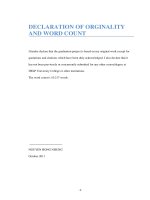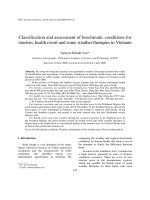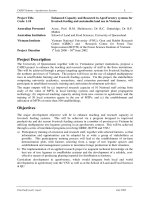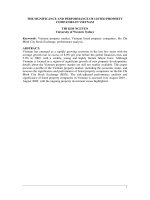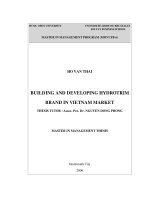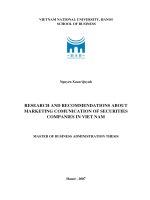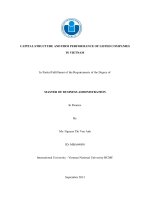Transformational leadership and organizational performance companies in vietnam
Bạn đang xem bản rút gọn của tài liệu. Xem và tải ngay bản đầy đủ của tài liệu tại đây (1.22 MB, 69 trang )
VIETNAM NATIONAL UNIVERSITY, HANOI
VIETNAM JAPAN UNIVERSITY
---------------------------
NGUYEN MINH HANG
TRANSFORMATIONAL LEADERSHIP
AND ORGANIZATIONAL
PERFORMANCE: COMPANIES IN
VIETNAM
MASTER'S THESIS
BUSINESS ADMINISTRATION
Hanoi, 2018
VIETNAM NATIONAL UNIVERSITY, HANOI
VIETNAM JAPAN UNIVERSITY
------------------------
NGUYEN MINH HANG
TRANSFORMATIONAL LEADERSHIP
AND ORGANIZATIONAL
PERFORMANCE: COMPANIES IN
VIETNAM
MAJOR: BUSINESS ADMINISTRATION
CODE: 60340102
RESEARCH SUPERVISORS:
DR. PHAM THI LIEN
PROF. DR. DANIEL ARTURO HELLER
Hanoi, 2018
TABLE OF CONTENTS
ACKNOWLEDGEMENT
ABSTRACT
LIST OF TABLES
LIST OF FIGURRES
LIST OF ABBREVIATIONS
INTRODUCTION .......................................................................................................1
Background to the research problem ......................................................................1
Research objectives and contributions ....................................................................2
The scope of the study.............................................................................................3
Research design .......................................................................................................3
The structure of the paper .......................................................................................3
CHAPTER 1. LITERATURE REVIEW ....................................................................5
1.1. Overview .......................................................................................................5
1.2. Leadership styles ...........................................................................................5
1.2.1.
Transactional leadership ......................................................................5
1.2.2.
Transformational leadership ................................................................6
1.3. Organizational learning .................................................................................9
1.3.1.
Organizational learning: Definitions and classification ......................9
1.3.2.
Organizational learning: Measurements ............................................11
1.4. Innovation ....................................................................................................12
1.4.1.
Innovation: Definitions......................................................................12
1.4.2.
Innovation: Measurements ................................................................15
1.5. Organizational performance ........................................................................15
1.5.1.
Organizational performance: Definitions ..........................................15
1.5.2.
Organizational performance: Measurements ....................................17
1.6. The relationship ...........................................................................................18
1.7. The conceptual framework of the study ......................................................20
1.7.1.
Transformational leadership, Organizational learning and Innovation
20
1.7.2.
Organizational learning, Innovation and Organizational performance
22
1.7.3.
Transformational leadership and organizational performance ..........23
CHAPTER 2. RESEARCH MODEL AND DATA COLLECTION .......................26
2.1. Overview .....................................................................................................26
2.2. Research model............................................................................................26
2.2.1.
Variables and measures in the research model ..................................26
2.2.2.
Research issues, hypotheses, and questions ......................................28
2.3. Data collection process ................................................................................29
2.4. Questionnaire design and administration ....................................................30
2.5. Sample demographics ..................................................................................31
CHAPTER 3. DATA ANALYSIS AND MEASUREMENT MODELS .................32
3.1. Overview .....................................................................................................32
3.2. Data preparation ..........................................................................................32
3.3. Descriptive statistics ....................................................................................32
3.4. Measurement tests .......................................................................................34
3.4.1.
Reliability ..........................................................................................34
3.4.2.
Validity ..............................................................................................34
3.4.3.
Pearson Correlation Analysis ............................................................35
3.4.4.
Harman’s single factor test ................................................................36
3.4.5.
Regression Analysis ..........................................................................36
CHAPTER 4. CONCLUSIONS AND IMPLICATIONS.........................................39
4.1. Overview .....................................................................................................39
4.2. Research findings ........................................................................................39
4.3. Contributions and implications ....................................................................42
4.4. Limitations and further research ..................................................................43
4.5. Conclusion ...................................................................................................44
REFERENCES ..........................................................................................................46
APPENDIXES ..........................................................................................................57
Appendix 1: Questionnaire ...................................................................................57
Appendix 2: Invitation letter .................................................................................61
ACKNOWLEDGMENT
I would like to express my gratitude to my advisors Associate Professor Doctor
Pham Thi Lien and Professor Daniel Arturo Heller for their enthusiastic guidance
and support. They accompanied with me over different phases of my master thesis
and gave me a helping hand whenever I need their advice.
Also, I would like to thank my family who always encourages me to complete
this research. I appreciate the support of my dear friends who are enthusiastically
willing to help me over difficulty. I thank all people, acquaintance, and strangers who
helped me to accomplish this research survey.
ABSTRACT
The study aims to investigate the relationship between transformational
leadership and organizational performance, with the mediating roles of
organizational learning and innovation. Data were collected from 86 respondents
who are currently CEOs/ Directors/ Founder of the Vietnamese companies to analyze
the model of the research. Based on the factor analysis, the 15 variables of the data
collected were demonstrating the positive and significant influence that
transformational leadership has on business performance, consequently gain some
implications for practice in the Vietnamese context.
Keywords: transformational leadership, organizational learning, innovation,
organizational performance.
LIST OF TABLES
Table 1.1. Comparison between transformational and transactional leadership…..8
Table 1.2. A summary of OL concepts……………………………………………10
Table 1.3. OL dimensions…………………………………………………………11
Table 1.4. The mainstreams of innovation typologies…………………………….14
Table 1.5. The mainstreams of innovation measurements………………………...15
Table 1.6. Summary of TL and OP in the literature……………………………….24
Table 2.1. Constructs of the measurement scale of the study……………………...27
Table 2.2. Frequency of the respondents’ profile…………………………………..31
Table 3.1. Variables code names…………………………………………………...32
Table 3.2. Descriptive statistics of all variables in this study………………………33
Table 3.3. Cronbach’s Alpha of the variables evaluated…………………………..34
Table 3.4. Factor Loadings ………………………………………………………...35
Table 3.5. Pearson Correlation Analysis…………………………………………...35
Table 3.6. Regression Analysis (Dependent variable: Organizational learning)…..36
Table 3.7. Regression Analysis (Dependent variable: Innovation)………………..36
Table 3.8. Regression Analysis (Dependent variable: Organizational performance)37
Table 3.9. Regression Analysis (Dependent variable: Organizational performance)38
Table 4.1. Summary of the results of hypotheses testing…………………………..41
LIST OF FIGURES
Figure 1.1. The research framework by (Orabi, 2016)…………………………….18
Figure 1.2. The research framework by (Mutahar, Rasli, & Al-ghazali, 2015)…...19
Figure 1.3. The research framework by (García‐Morales, Matías‐Reche, &
Hurtado‐Torres, 2008)……………………………………………………………..19
Figure 1.4. The research model for the study……………………………………...20
LIST OF ABBREVIATIONS
IN
innovation
OL
Organizational Learning
OP
Organizational Performance
TL
Transformational leadership
INTRODUCTION
Background to the research problem
Transformational leadership (TL) places a great impact on the ethical attitudes and
behavior of an organization’s individuals, providing a common purpose to achieve
goals of organizations. According to Bass (2000), TL normally leads to better
performance than transactional leadership. Previous researchers show that the
transformational leaders emphasize a crucial influence on firms’ performance,
comprehension of the processes in which followers have more freedom and decisionmaking capability is still theoretical (Gary Yukl, 1999).
In the time of information creation, knowledge learning and innovation capability are
elements to create, renew and apply knowledge to establish core competencies for
firms improvements. (Barrett & Sexton, 2006), (Nonaka & Takeuchi, 1995).
Although learning about TL and OP has existed in previous research overseas, there
are a few papers researching about this topic in Vietnamese enterprises. In the past
few years, there have been some research on leadership styles, and so is
transformational leadership style in the Vietnamese context, they are:
-
Changing leadership style in the Vietnamese Commercial Banks before and
after Vietnam joins the WTO. (Cuong & Minh, 2017).
-
Leadership
styles
of
Vietnamese
higher
educational
leaders:
Transformational, transactional, or laissez-faire. (Thu, Pillay, & Mergler, 2017).
-
Transformational and transactional leadership styles and employees’ job
satisfaction in Vietnamese local companies. (Ho & Le, 2016).
-
The influence of leadership behaviors on employee performance in the context
of software companies in Vietnam. (Ha & Nguyen, 2014).
-
Leadership styles and generational effects: examples of US companies in
Vietnam. (Cox, Hannif, & Rowley, 2014).
-
Educational leadership in the Vietnamese context. (Dung, 2014).
1
-
Effective leadership in joint – ventures in Vietnam: a cross-cultural
perspective. (Quang, Swierczek, & Chi, 1998).
According to the author’s research, the number of study about TL in Vietnam is very
limited, so is the study on the relationship between two aspects. This motivates
research in the situations of Vietnamese companies.
Research objectives and contributions
The study aims to research on the relationship between transformational leadership
and business performance in Vietnamese companies, in the current context of
developing stage of business, opening many opportunities for small and medium-size
companies to start up and to grow. In this context, leadership style is one of the most
important elements that influence the business strategy of the companies,
organization's performance, reputation, and image. (Conger & Kanungo, 1988). It is
also considered to create the difference for the organization’s image, supporting the
achievement of business performance as well as the strategic development and
maintaining the competitive advantages for the company. (Bass, 1985). (Bass, 1990)
also reported that an appropriate leadership style is confirmed to explain 45 to 60
percent of the organizational performance. Regarding the effectiveness of
transformational leadership style on business performance, based on the previous
studies by researchers all around the world, this study was aimed to investigate the
following objectives:
-
To study the impact of transformational leadership on organizational learning
and innovation.
-
To identify the influence of organizational learning and innovation on business
performance in the Vietnamese context empirically.
The research objectives are transformed into research questions and hypotheses to be
explained in this study. Therefore, the study makes contributions as follows:
-
Reviewing the literature on transformational leadership, organizational
2
learning and innovation and its impact on business performance.
-
Establishing and confirming the model of transformational leadership impact
on organizational performance.
-
Implying the practice of transformational leadership in the Vietnamese
context, to support the growth and sustainability of business development in Vietnam.
The scope of the study
This study investigated the perception of managers in Vietnamese companies
currently, about transformational leadership and its impact on business performance,
with the mediating roles of organizational learning and innovation. A total of 86
CEOs/ Founders/ Directors were providing their understanding and insight of their
companies.
Research design
The research chooses to use the quantitative methodology for the data collection and
analysis. Others were descriptive, explanatory and literature review, which were used
to provide background theory for the research problems and propose research model
and hypotheses.
For the survey, a questionnaire was distributed to citizens who are CEO/ Founders/
Directors of companies in Vietnam. The data collected then were analyzed using
SPSS22 to test the validity and reliability, for descriptive analysis and regression
analysis, which will be discussed later in chapter 3.
The structure of the paper
The thesis provides knowledge of the relationship between transformational
leadership and organizational performance, with the mediating roles of organizational
learning and innovation, in theory, and practice. There are four chapters, including a
chapter of literature review, three chapters of data collection and analysis and a
conclusion.
The introduction provides the summary and introduction of the entire research,
3
background, and objectives of the thesis were included.
Chapter 1 reviews and summarizes the previous research related to the theory of TL
and OP, with the study of mediating variables including organizational learning and
innovation.
Chapter 2 discusses the research model and data collection process.
Chapter 3 discusses the data analysis, basing on the data collected using methodology
mentioned in the previous chapter, summarizes the result of the study.
Chapter 4 concludes the work with the discussion on the problems stated throughout
the research and discusses implications for theory and practice, with limitations of
the study, implying for further research orientation.
4
CHAPTER 1. LITERATURE REVIEW
1.1.
Overview
This chapter has six sections. After the overview of the entire chapter, the following
four sections are reviewing the literature of the related variables to the research, which
is respectively transformational leadership, organizational learning, innovation and
business performance. The final part of this chapter describes the relationship
between variables in the research model and proposes a research model for this study.
1.2.
Leadership styles
Human resource development theory concentrated on leadership characteristics, as it
focused on the relationship between leaders and followers in organizations. (Bass &
Avolio, 1991), (Bass & Avolio, 1993). The types of such connections exist in both
transformational and transactional leadership styles. (Rowold, 2008). Both of these
two styles were developed by Burns (1978) and then developed by Bass and Avolio
(1991), the concepts of the two leadership styles aforementioned will be presented in
the following sections.
1.2.1. Transactional leadership
Transactional leadership can also be called managerial leadership, is the leadership
style that concentrates on the supervision capability of the leaders. In the original
meaning of the transactional leadership, leaders promote compliance of their
subordinates by rewards and punishments, basing on the transactions between leaders
and followers. (Sultana, Darun, & Yao, 2015). This leadership style is considered to
be effective when firms are unstable that requires careful supervision. According to
Burns (1978), transactional leaders have the short-term relationship with followers.
Some previous researchers criticized this leadership style because it is considered to
be a one – size – fits – all characteristics of the leaders. (McCleskey, 2014). Sultana,
Darun & Yao (2015) considered the human relationship in this leadership style is
"nothing but a chain of transactions". This leadership style rooted from rewards,
5
penalties, economic status and anything of "transactions". (Sultana et al., 2015).
Odumeru & Feanyi (2013) summarized the three characteristics of a transactional
leader: they are more directive and action-oriented, inside-the-box-thinking, and
generally passive.
1.2.2. Transformational leadership
Transformational leadership is acknowledged as a leadership style exercise that
causes changes for both individual and society. In the original ideally definition, TL
creates priceless and significant changes for the followers’ behavior with the end
goals of transforming ordinary employees into leaders, which can be considered
motivational and encouraging. (Bass, 1999). In its authentic form, TL was
demonstrated to increase the morale and motivation of subordinates using different
mechanisms, including attaching the subordinates’ personality and objectives to the
organizational development; becoming a role model for employees, inspiring and
challenging them to take greater ownership of their own positions, understands the
strengths and weaknesses of each staff to align subordinates with tasks that help them
to standardize and optimize their working performance. (Choi, Goh, Adam, & Tan,
2016).
James Mac Gregor Burns (1978), in his explanatory study on political leaders, was
the first author to introduce the definition of transforming leadership. He introduced
two concepts of leadership, “transformational leadership” and “transactional
leadership”. Burns explained that transforming leadership means that “leaders and
followers help each other to advance to a higher level of morale and motivation”. He
also linked this to the difficulty in clarification between leaders and managers, while
claiming that the differences exist in behaviors and characteristics. TL creates
significant changes in people’s lives and in the entire firms. (Hanaysha et al., 2012).
A transformational leader is someone who motivates his or her subordinates with
outstanding results. (Robbins & Coutler, 2007). While transactional leadership is
based on “give and take” philosophy, TL is based on the leaders’ characteristics, traits
and capability to make a breakthrough for the organization through example,
6
courageous visions and challenging results. Transformational leaders are idealized
because they have become an example of working for teams’, firms’ or communities’
benefits. Burns also conceptualized that transformational leaders can strive to change
their organizational culture for the better, while transactional leaders do not usually
challenge themselves for the cultural change toward the better.
In 1985, Bernard M. Bass developed the research of Burns (1978) by proving the
psychological theory of transforming and transactional leadership, he expressed
“transformational leadership” instead of “transforming leadership”. Bass introduced
the theory that a leader is considered transformational or not is by their impact on the
followers. Their employees feel trust, loyalty, respect, and admiration to them, and
because of that, they are willing to perform exceptionally harder and more
enthusiastic at work. These results happen because the transformational leaders offer
their subordinates a lot more than individual improvement, they transform and
motivate their employees with his or her idealized influence, intellectual stimulation
and individual consideration. Furthermore, transformational leaders motivate
followers to invent new and unique ways of problem-solving and support for their
individual success.
Regarding the transformational leadership, four elements are introduced, they are
Idealized influence, Inspirational motivation, Intellectual stimulation, and Individual
consideration.
Idealized Influence – Leaders behave in the ways that employees feel trust and
respect, using the sensitivity to understanding others needs and wants.
Inspirational Motivation – The leader provides a vision that is attractive and
motivational to his or her subordinates. Leaders with inspirational motivation
challenge their followers with high standards, communicate optimism about their
objectives, while also introducing to them meaningful guidelines for their tasks.
Followers, in this case, need to have a strong sense of purpose, purposes, and meaning
help the group drive forward. The leaders' visionary is supported by communication
skills which help explain that vision comprehensive, precise, powerful and engaging.
The employees are willing to pay more effort while at work, feel more encouraged
7
and confident about their future and improve confidence in themselves.
Intellectual Stimulation – The leaders challenge, take risks and encourage
employees’ ideas. Leaders with Intellectual Stimulation will appreciate creativity in
their followers, establish and propose for creative and independent staff. For them,
learning is precious and unexpected outcomes are considered opportunities to learn.
Following them, their subordinates are independent and challenge themselves with
better ways of solving problems and implement their methodology.
Intellectual Consideration – The leaders behave as a mentor for their followers, give
them empathy and support, keep the relationship with employees open and
comfortable, while still place challenges for them to grow. In this case, the followers
also need to have a determination for their individual growth and intrinsic motivation
for their own work.
Table 1.1. Comparison between transformational and transactional leadership
Transactional Leadership
Transformational Leadership
Leaders are responsive;
Leaders are proactive;
Leaders
work
within
the
Leaders always strive for cultural
organizational culture;
Followers
achieve
changes for the better;
rewards
and
Followers achieve objectives through
punishment basing on performance;
their personal perception of value and
knowledge sharing;
Leaders
motivate
focusing
on
employees
their
by
Leaders motivate employees by
individual
focusing on the achievement of the
objectives;
entire group; while still understand
strengths and weaknesses of each
subordinate;
Leaders
maintain
the
working
Leaders promote new ideas and
conditions, emphasize on actions to
encourage followers to think outside
improve performance;
the box, establish a creative and
innovative working environment.
Source: Adopted from Odumeru & Feanyi (2013)
8
Understanding the characteristics of Transformational and Transactional leadership,
and from the literature review, this study will focus on the Transformational
leadership style.
1.3.
Organizational learning
1.3.1. Organizational learning: Definitions and classification
OL was introduced for the first time in 1963 by Cyert & March (1963), both authors
believed that organizations’ determination to challenge the external environment to
match with their aims of conditions and procedures, will help them to pursue more of
their final business objectives. (Saadat & Saadat, 2016).
According to Jain & Moreno (2015), OL can be viewed as a vital prescriptive process
that enables an organization to grow as well as to develop their core competencies.
OL has been broadly explained in the literature as a learning process within an
organization which involves the interaction of multi-levels of analysis which are
individual, group, internal and external environmental factors. (Dodgson, 1993).
According to Wang and Ahmed (2003), there are five focuses of OL concepts, which
are: Collectivity of individual learning, process or system, culture or metaphor,
knowledge management, continuous improvement and incremental innovation.
(Wang & Ahmed, 2003).
The first focus is the collectivity of individual learning. The learning concept rooted
from different perspectives, mostly concentrated in the psychology research, the
process of individual learning places an effect on OL concept because a learning
organization is built from the personal learning process in the organization. However,
previous researchers also pointed out that individual learning does not always cause
organizational learning.
Table 1.2. A summary of organizational learning concepts
Focus
Individual
The concept of organizational learning
“Organizational
learning occurs when individuals within an
9
learning
organization experience a problematic situation and inquire into
it on the organizational behalf” (Argyris & Schön, 1978)
Process
of Organizational learning is the procedure in which organizations
system
comprehend and reproduce with their experience (Glynn,
Milliken, & Lant, 1992)
Culture
of “A learning organization should be viewed as a metaphor rather
metaphor
than a distinct type of structure, whose employees learn
conscious communal process for continually generating,
retaining and leveraging individual and collective learning to
improve performance of the organizational system in ways
important to all stakeholders and by monitoring and improving
performance”. (Drew & Smith, 1995)
Knowledge
“Organizational learning is the changes in the state of
management
knowledge”. (Lyles A., 1988)
“Learning is the process of linking, expanding and improving
data and information, knowledge and wisdom”. (Bierly,
Kessler, & Christensen, 2000)
Continuous
A learning organization is “an organization that facilitates the
improvement
learning of all its members and continuously transforms itself
and incremental
and its context”. (Pedler, Boydell, & Burgoyne, 1997)
innovation
Source: Adopted with update from Wang and Ahmed (2003).
Organizational learning classification:
Although there are various types and levels of learning researched by previous
authors, there can be classified with the three-fold typology of learning by Argyris &
Schön, (1978):
Single – loop learning (Following the rules). The traditional template description
for the concept is the thermostat which has one mode function. Similarly, the single
10
– loop learning includes one automatic and limited type of reaction – little or no
learning occurs and little or no sight is required. Previous researchers asserted that
most organizations follow this single – loop learning, which can be linked with tasks
that broaden the knowledge base or firms’ capability without having to change the
nature of their basis. (Dodgson, 1993).
Double – loop learning (Changing the rules). Members of the organization are
capable of reflecting whether the rules should be changed and how to change the
rules, not only when deviations have occurred. This learning style involves more of
the “thinking outside the box”, creative and critical thinking. Regarding this learning
type, members of the organization understand better about why a particular solution
is more effective than others, and they are more capable of solving problems or pursue
a goal. Experts asserted that double – loop learning is essential to the organizational
successful rate. This is also regarded as a higher level of learning, generative learning
or exploration learning.
Triple – loop learning (Learning about learning). Members of the organizations
learn how to learn, by reflecting on and inquire into previous contexts for learning.
In this situations, participants express their thoughts and opinions about regulations,
not only whether they should be adjusted.
1.3.2. Organizational learning: Measurements
According to Gomes & Wojahn (2017), the OL capability has four dimensions, as
described in table 1.3:
Table 1.3. Organizational learning dimensions
Dimension
Variables and Indicators
Authors
Support for new ideas
Favorable responses to initiatives of
Experimentation
(Schein, 1993)
employees
Change valorization
11
Change facilitation
Collection and reporting of information
Interaction with
from the external environment
the external
Receiving and sharing information
environment
Interaction of people with the external
(Amabile, Conti,
Coon, Lazenby, &
Herron, 1996)
environment
Encouragement in coping with new
situations
Take risks that do not harm the company
Propensity to
risk
Resources for projects that involve new
(Chiva, Alegre,
Vale, & Lapiedra,
situations
Making decisions without having all the
2007)
information
Encourage employees to communicate
Free and open communication within
Dialogue
(Torres, 2011)
work teams
Facilitation of communication within the
company
Presence of cross-functional work team
Source: Adapted from Gomes & Wojahn (2017)
According to Kale, P.; Singh, H.; Perlmutter (2000), learning capability can be
defined as the ability to acquire new and important information from others. In this
study, the construct will be applied from the study abovementioned, to explain the
learning capability of the Vietnamese enterprises.
1.4.
Innovation
1.4.1. Innovation: Definitions
Innovation currently is considered at the top of the strategic agendas for
organizations. (Tzeng, 2009). Innovation is broadly regarded as determining factor
12
affecting the economic growth because it generates high productivity and
competitiveness. (Abrunhosa & Sa, 2008). According to many researchers,
innovation is an analytical source of competitive advantage for any organization.
(Abidin, Sanuri, Mokhtar & Zien, (2013), Hansen (2014), Gunday, Ulusoy, Kilic &
Alpkan (2009).
Previous researchers have demonstrated several definitions of innovation, which can
be summarized as follow:
“Innovation is the commercial or industrial application of something new – a new
product, process or method of production; a new market or sources of supply; a new
form of commercial business or financial organization”. (Schumpeter, 1934)
According to the European Commission, Innovation is the alternations and
improvements of products, services and market ranges, the development of
productions methods, supply chain management and distribution of products and
services; the introduction of new management method alternatives, working
environment and human skills. (CEC, 1995).
Bona & Mustafa (2013) conceptualized innovation as the creation of behaviors or
ideas that bring the organization to a new level of production. Consequently,
innovation is not exclusively the definition of R&D field; it is the multidimensional
procedure, with multiple inputs which come from different interactions among
individuals, departments, and organizations.
Innovation is crucial for any organization because, in the knowledge creation time,
companies see it as a strong indicator of business achievement, a way to create
profitable growth, increase competitive advantage and improve organization’s
performance. (Potters, 2009).
According to previous researchers, innovation has various types that are related to
different characteristics, as described in the table below:
13
Table 1.4. The Mainstreams of Innovation Typologies.
Innovation typology
Radical
versus
Key features
Innovation Incremental
Radical
Authors
innovations
are (Abrunhosa & Sa,
innovations that are totally new 2008)
Innovation
and are exceptionally different (Lin & Chen, 2007)
from
existing
products
and (Forsman & Temel,
services;
-
2011)
Incremental
innovations
innovations
that
are
involve
revisions of alternations to the
existing products or services;
Technological
Innovations
versus
Technological innovations are (Bona & Mustafa,
the
Marketing Innovation
adoptions
technologies
of
new 2013)
that
are (Damanpour,
incorporated into processes or Walker,
products;
-
Marketing
&
Avellaneda, 2009)
innovations
associated
with
are (Auken, 2008)
internal
processes supporting the delivery
of a service or product;
Product
Innovation -
versus
Process
Product innovations are creating (Gunday
et
al.,
new or improved versions for 2011a)
Innovation
products or services;
-
(Singh & Smith,
Process innovations are focusing 2004)
on improving the effectiveness (Prajogo & Sohal,
and efficiency of production;
2006)
Source: Adopted from Suroso & Azis (2015)
14
1.4.2. Innovation: Measurements
Table 1.5. The mainstreams of Innovations measurements
Mainstreams of
Key characteristics
Authors
Innovations
measurements
Input and Output Researchers
measurement
emphasizes
the (Bona & Mustafa, 2013)
importance of output indicators (Singh & Smith, 2004)
in innovation measurement, but (Prajogo & Sohal, 2006)
most of the previous research is (Auken, 2008)
still predominantly focusing on (Gunday et al., 2011a)
the input ingredients.
Metric
and Surveys,
questionnaires, (Damanpour et al., 2009)
methodologies
balance
scorecards,
various (Lin & Chen, 2007)
measurements
mathematical models and other (Abrunhosa & Sa, 2008)
methods. Different standards
and methodologies are used in
different
situations
and
organizations.
Source: Adopted from Suroso & Azis (2015)
Although there have been numerous researchers on analyzing organizations’
innovations with reliable measurement scales (Kusunoki, Nonaka, & Nagata, 1998),
(Miller & Friesen, 1983). In this study, the previously used measure developed by
Miller & Friesen (1983) will be applied.
1.5.
Organizational performance
1.5.1. Organizational performance: Definitions
Successful organizations represent a key ingredient for developing countries. OP is
considered one of the most crucial indicators in the management and strategic
15
research and arguably the most important determinant of the organization. (Gavrea,
Ilies, & Stegerean, 2011).
In the 50s, OP was defined as how firms managed to achieve their objectives.
(Tannenbaum & Basil S. Georgopoulos, 1957). In this period of management,
performance evaluation was concentrated on work, human resources, and
organizational construct. Later in the 60s and 70s, OP is concluded as the ability that
an organization presents the outcome from their limited inputs. (Seashore &
Yuchtman, 1967). Between the 80s and 90s, the definition became complex as the
development and objectives of organizations are constructed to the extent that the
organizations carried out their goals effectively and efficiently, within their limited
resources. (Lusthaus & Adrien, 1998).
According to Reichard (2002), performance is a broader indicator that includes
human productivity, consistency and product and service quality. It also measures
results, behaviors, and relative measures, education, and training concepts and
instruments, gathering management development and leadership training for
establishing essential skills and attitudes of performance management.
Many previous researchers have conceptualized firm performance by return on
investment, return on assets, return on equity, market share, sales growth, revenue
growth, stock price, sales volume, and profit before tax. (Droge, Vickery, &
Markland, 1994). Organizations established strategic goals after carefully
considering the internal and external factors as they tried to match that capability with
opportunities and challenges. (Nyenze & Kaleli Kyongo, 2017).
According to Lebas & Euske (2006), organizational performance concept can be
illustrated as follow:
-
Performance is a set of both non – financial and financial variables that provide
information to the degree of outcomes and results;
-
Performance is a dynamic criterion, critical for evaluation and translations;
-
Performance may be viewed differently from the different point of view;
16
-
Performance can be described using a causal model that illustrates the effect
of present activities on the future outcomes of the organization;
-
The definition of the concept of performance requires knowing its elements
features of each responsibility;
-
The level of organizational performance requires knowledge of results
evaluation and translations.
1.5.2. Organizational performance: Measurements
Baird (1986) argued that performance is action – oriented. Similarly, Lebas & Euske
(2006) also agreed in saying that performance referred to actions, results of actions
and the success of organizations. Viewing performance as a complex judgment will
capture some of this characteristics.
Measuring the results of an organization, profitability ratios and business productivity
are often used. (Regev, 1998). In addition, financial outcomes are usually used to
quantify results of an organization. These are return on investment, return on equity,
or using the factors of efficiency and service quality. (Gopalakrishnan & Damanpour,
2001). Although organizational performance theory and research have been widely
studied and reviewed, and it is considered one of the core objectives of research in
both entrepreneur and strategic management studies (Venkatraman & Ramanujam,
1986), there is still no consensus regarding the measures of this definitions. (Pham &
Jordan, 2006). Schriesheim, Castro, Tracy & Dechurch (2006) also agree that
measuring organizational performance is a persistent source of argument and critique
over the past centuries. Organizational performance studies have inconsistent
outcomes because of the differences of the sample that researchers used in their
studies, the variance in the measurement applied and the lack of consensus of the
goals of evaluating performance. (Pham & Jordan, 2006). Performance has been
conceptualized in numerous ways by various researchers. It can be measured by
historical data of the organization (Bharadwaj, 2000) or perception of respondents
who are working in the organization, regarding their working expectations and
objectives or in comparison with their companies’ competitors. (Ravichandran &
17
